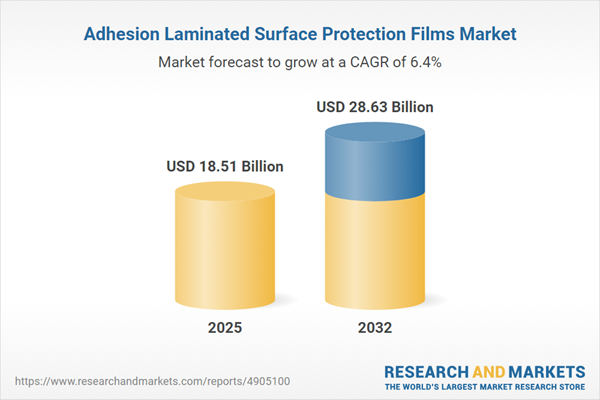Speak directly to the analyst to clarify any post sales queries you may have.
Adhesion laminated surface protection films are driving change across manufacturing landscapes, serving as essential barriers for sensitive surfaces under challenging production, transport, and installation environments. Senior decision-makers benefit from understanding how their robust performance and evolving capabilities meet the needs of industries striving for cost-effective and reliable product integrity.
Market Snapshot: Global Adhesion Laminated Surface Protection Films
The adhesion laminated surface protection films market grew from USD 17.41 billion in 2024 to USD 18.51 billion in 2025, projecting sustained momentum with a CAGR of 6.41% through 2032. Expected to reach USD 28.63 billion by 2032, this market spans continents and serves a wide range of end-use sectors, including automotive, electronics, construction, and industrial manufacturing. Recent technological advances, regulatory shifts, and region-specific demand drivers are accelerating innovation and reshaping strategies for global suppliers and purchasers within this sector.
Scope & Segmentation
- Film Types: Polyester, Polyethylene, Polypropylene, Polyvinyl Chloride
- Adhesive Types: Acrylic, Rubber, Silicone
- Thickness Range: 100 to 200 micron, 50 to 100 micron, Less than 50 micron, More than 200 micron
- Release Liner Formats: Film liner, Paper liner
- Coating Processes: Corona treatment, Flame treatment, Plasma treatment
- End Use Industries: Automotive (OEM), Construction (Commercial, Infrastructure, Residential), Electronics (Consumer electronics, Industrial electronics, IT equipment), Furniture, Industrial Manufacturing, Medical
- Key Applications: Decorative protection, Electroplating masking, Painting masking, Powder coating masking, Screen protection films, Welding masking
- Regional Coverage: Americas (North America: United States, Canada, Mexico; Latin America: Brazil, Argentina, Chile, Colombia, Peru), Europe, Middle East & Africa (Europe: United Kingdom, Germany, France, Russia, Italy, Spain, Netherlands, Sweden, Poland, Switzerland; Middle East: United Arab Emirates, Saudi Arabia, Qatar, Turkey, Israel; Africa: South Africa, Nigeria, Egypt, Kenya), Asia-Pacific (China, India, Japan, Australia, South Korea, Indonesia, Thailand, Malaysia, Singapore, Taiwan)
- Companies Analyzed: 3M Company, Nitto Denko Corporation, Avery Dennison Corporation, LINTEC Corporation, Scapa Group plc, tesa SE, Berry Global Group, Inc., Cosmo Films Limited, Lohmann GmbH & Co. KG, Intertape Polymer Group Inc.
Key Takeaways for Senior Decision-Makers
- The primary keyword "adhesion laminated surface protection films" represents a pivotal category in safeguarding high-value assets during production and logistics, responding to industry needs for cost management and robust protection.
- Advancements in adhesive chemistry—such as low-residue removal systems and specialized thicknesses—enable manufacturers to tailor film performance for electronics, automotive, and industrial applications.
- Technologies including corona, plasma, and flame treatments optimize film surface compatibility, enhancing durability and enabling customized functionalities such as traceability and branding via digital printing.
- Geographical strategies are evolving. Manufacturers are investing in local production hubs, joint ventures, and supplier alliances to improve capacity and resilience, especially in growth regions like Asia-Pacific and EMEA.
- Sustainability pressures, particularly in Europe and North America, are influencing innovation around recyclable liners, biodegradable substrates, and low-VOC adhesive systems.
Tariff Impact: Navigating Cost and Supply Disruptions
With the enactment of new tariffs in the United States in 2025 on raw materials such as polyester, polyethylene, silicone, and rubber adhesives, manufacturers adjusted strategies to safeguard margins and secure supply chains. Shifting procurement to optimize regional suppliers and pursuing long-term vendor agreements, industry stakeholders are reinforcing domestic capabilities and exploring alternative resin and liner options. Agility in logistics and vertical integration have emerged as tactical levers to mitigate ongoing cost volatility prompted by geopolitical actions.
Methodology & Data Sources
Findings are based on dual-method research, blending primary interviews with senior executives, R&D leaders, procurement experts, and regulatory authorities, alongside extensive secondary research from trade associations, technical journals, patents, and policy documents. Structured segmentation and supply chain mapping ensure quantitative accuracy and qualitative depth for actionable strategic insights.
Why This Report Matters
- Offers benchmarking of product innovations, sustainability advances, and evolving regulatory mandates affecting decision-making in multiple regions.
- Equips leaders with strategic guidance to enhance procurement, streamline logistics, and drive new application development within the adhesion laminated surface protection films sector.
- Enables robust risk management by mapping the impact of tariffs and regulatory changes on cost structure and supply continuity.
Conclusion
The report clarifies how industry leaders can mobilize cutting-edge film technologies, optimize global operations, and stay aligned with sustainability principles. Agile supply chains and innovation-centric culture are essential in a market facing continuous change.
Additional Product Information:
- Purchase of this report includes 1 year online access with quarterly updates.
- This report can be updated on request. Please contact our Customer Experience team using the Ask a Question widget on our website.
Table of Contents
3. Executive Summary
4. Market Overview
7. Cumulative Impact of Artificial Intelligence 2025
Companies Mentioned
The companies profiled in this Adhesion Laminated Surface Protection Films market report include:- 3M Company
- Nitto Denko Corporation
- Avery Dennison Corporation
- LINTEC Corporation
- Scapa Group plc
- tesa SE
- Berry Global Group, Inc.
- Cosmo Films Limited
- Lohmann GmbH & Co. KG
- Intertape Polymer Group Inc.
Table Information
| Report Attribute | Details |
|---|---|
| No. of Pages | 197 |
| Published | November 2025 |
| Forecast Period | 2025 - 2032 |
| Estimated Market Value ( USD | $ 18.51 Billion |
| Forecasted Market Value ( USD | $ 28.63 Billion |
| Compound Annual Growth Rate | 6.4% |
| Regions Covered | Global |
| No. of Companies Mentioned | 11 |









